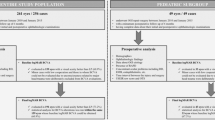Abstract
Background
Open globe injuries are the most serious eye injuries in war as in peace time. The purpose of this study is to analyze wartime open globe eye injuries in 72 patients treated at the Department of Ophthalmology, Clinical Hospital of Split from July 1991 to April 1993, during the intensive war in Croatia and Bosnia and Herzegovina, and to evaluate crucial factors responsible for the functional success of the treatment.
Methods
Wartime open globe eye injuries were retrospectively analyzed in 72 patients (80 eyes) hospitalized at Clinical Hospital of Split, Department of Ophthalmology, between July 1991 and April 1993. The causes and ways of wounding, localization of wounds and presence, nature and localization of the foreign body, as well as admission time, microsurgical management and other factors contributing to poor visual outcome were studied. Standard international classification of ocular traumas (the Birmingham Eye Trauma Terminology and the International Ocular Trauma Classification) was used for the classified and graded injuries.
Results
Open globe eye injuries amounted to 52.65% of all war injuries to the eyes. Bilateral injuries were found in eight patients (11.11%). The most frequent cause of the injures were fragments of explosive devices (more than two-thirds). Most of the patients were admitted to the hospital within 24 hours of the injury. Using current microsurgical techniques, the attempt was made to achieve not only anatomical but also functional recovery already in the primary treatment. In 30 eyes (37.50%) final visual acuity amounted to more than 0.1, and in 22 eyes (27.50%) it reached 0.5. There was a statistically significant correlation between admission within the first 12 hours and postoperative improved visual acuity (χ2 = 4.53; p = 0.033). Statistically significantly better visual acuity was found in patients with lesions limited to the anterior segment of the eye. Primary enucleation or evisceration was performed only exceptionally: one enucleation and six eviscerations (8.75%).
Conclusion
The most important factors in the prognosis of postoperational visual acuity for wartime open globe eye injuries were: (1) preoperative condition of the eye, (2) localization and extent of the wound, (3) presence, size and nature of foreign bodies, and (4) adequate surgical treatment in specialized institutions.







Similar content being viewed by others
References
Gombos GM (1969) Ocular war injuries in Jerusalem. Am J Ophthalmol 68:474–478
Treister G (1969) Ocular causalities in the six-days war. Am J Ophthalmol 68:669–675
Prodan I (1991) Ratne ozljde oka. In: Prodan I (ed) Hitna ratna kirurgija. Vigram, Zagreb, pp 258–271
Duke-Elder S (1972) War injuries. System of ophthalmology. Vol XIV. Henry Kimpton, London, pp 49–56
Duke-Elder S (1972) Perforating wounds of eye. System of ophthalmology. Vol XIV. Henry Kimpton, London, pp 323–346
Foulborn J, Atkinson A, Oliver D (1977) Primary vitrectomies as preventive surgical procedure in the treatment of severely injured eyes. Br J Ophthalmol 61:202–208
Sternberg P, Dejuan E, Michels RG, Aver C (1984) Multivariate analisis of prognostic factors in perforating ocular injuires. Am J Ophthalmol l98:467–472
Pieramici DJ, Sternberg P Jr, Aaberg TM Sr et al (1997) A system for classifying mechanical injuries of the eye (globe). The Ocular Trauma Classification Group. Am J Ophthalmol 123:820–831
Kuhn F, Morris R, Witherspoon CD et al (1996) A standardized classification of ocular trauma. Graefes Arch Clin Exp Ophthalmol 234:399–403
Kuhn F, Morris R, Witherspoon CD et al (1996) A standardized classification of ocular trauma. Ophthalmology 103:240–243
Kuhn F, Morris R, Witherspoon CD, Meister V (2004) The Birmingham Eye Trauma Terminology system (BETT). J Fr Ophtalmol 27(2):206–210
Kuhn F, Maisiak R, Mester V, Morris R, Witherspoon CD (2002) The ocular trauma score (OTS). Ophthalmol Clin N Am 15:163–165
Sobaci G, Multu FM, Bayer A, Karagul S, Yildrim E (2000) Deadly weapon-relation open-globe injuries: Outcome assessment by the ocular trauma classification system. Am J Ophthalmol 129:47–53
Stambuk V, Plestina-Borjan I, Karaman K, Zuljan I (1992) Ratne ozljede oka. Med An 18(1):57–66
Dufor D, Kromen Jensen S, Owen-Smith M, Samela J, Stening G, Zetterstorm B (1988) Surgery for victims of war. International Committee of the Red Cross, Geneva, pp 197–183
Kalenić S, Žele-Starčević L, Jarža-Davilča N, Jandrić M (1991) Infekcije ratnih ozljeda. Liječ vjesn 113:233–235
Janković S, Zuljan I, Sapunar D, Buca A, Plestina-Borjan I (1998) Clinical and radiological management of wartime eye and orbit injuries. Mil Med 163(6):423–426
Briton GS, Aaberg TM (1982) Changing aspects of management of ocular trauma. Am J Ophthalmol 94:258–260
Hutton W, Fuller DG (1984) Factors influencing final visual results in severely injured eyes. Am J Ophthalmol 97:715–722
Hp A, Taylor P, Fitzmaurica DJ (1976) Prognosis of perforating eye injury. Br J Ophthalmol 60:737–739
Barr C (1983) Prognostic factors in corneoscleral lacerationa. Arch Opthalmol 101:919–924
Šikić J (1992) War injuries of posterior eye segment and their treatment. Acta Med Croat 46:71–79
Benson W, Machemer R (1976) Severe perforating injuries treated with pars plana vitrectomy. Am J Ophthalmol 81:728–732
Michels RG (1975) Surgical menagement of nonmagnetic intraocular foreign bodies. Arch Opthalmol 93:1003–1006
Author information
Authors and Affiliations
Corresponding author
Additional information
The article was presented as a poster at the Third International Symposium on Ocular Trauma in Rome, Italy in June 2006, and received an award from the Helen Keller Foundation.
The authors have full control of all primary data, and they agree to allow Graefe´s Archive for Clinical and Experimental Ophthalmology to review their data on request.
None of the authors has a financial or proprietary interest in any material or mentioned in the article.
Rights and permissions
About this article
Cite this article
Plestina-Borjan, I., Medvidovic-Grubisic, M., Zuljan, I. et al. Wartime open globe eye injuries. Graefes Arch Clin Exp Ophthalmol 248, 305–312 (2010). https://doi.org/10.1007/s00417-009-1172-9
Received:
Revised:
Accepted:
Published:
Issue Date:
DOI: https://doi.org/10.1007/s00417-009-1172-9




